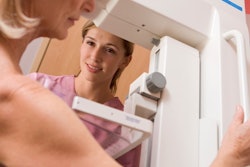
Older breast cancer survivors who have less than five years of life expectancy should no longer undergo routine surveillance mammography -- even if they have a history of high-risk cancers, according to new guidelines published online January 28 in JAMA Oncology by a multidisciplinary panel.
Approved by the International Society for Geriatric Oncology (SIOG), the new guidelines are intended to facilitate a personalized approach to surveillance mammography -- routine mammography performed in the absence of symptoms or examination finding -- in breast cancer survivors ages 75 and older. Specific recommendations are provided based on patient age, life expectancy, and risk factors.
"It is anticipated that these expert guidelines will enhance clinical practice by providing a framework for individualized discussions, facilitating shared decision-making regarding surveillance mammography for breast cancer survivors 75 years or older," wrote the authors led by Dr. Rachel Freedman of the Dana-Farber Cancer Institute.
| Surveillance mammography guidelines for older breast cancer survivors | |||
| Ages 75-79 | Ages 80-84 | Ages 85 and older, or any age if life expectancy is less than 5 years | |
| Patient history of low-risk cancers (most HR-positive and ERBB2-negative tumors and stage I ERBB2-positive or triple-negative tumors) | Continue annual or biennial surveillance mammography if life expectancy is 10 years. Consider discontinuing mammography if life expectancy is less than 10 years | Continue annual or biennial surveillance mammography if life expectancy is 10 years. Consider discontinuing mammography if life expectancy is less than 10 years | Discontinue surveillance mammography unless patient is in extraordinary health or has a strong desire to continue |
| Patient history of higher-risk cancers: stage II/III triple-negative or ERBB2-positive tumors and higher-risk HR-positive tumors | Continue annual surveillance mammography unless life expectancy is less than 5 years | Consider discontinuing surveillance mammography unless life expectancy is more than 5 years | Discontinue surveillance mammography unless patient is in extraordinary health or has a strong desire to continue |
Tailoring screening for survivors
Although annual screening mammography has previously been recommended in breast cancer survivors of all ages, there has been little guidance on how to tailor screening for survivors who are 75 or older, according to Freedman.
"The result is that the use of mammography for older survivors has been highly inconsistent," she said in a statement from the Dana-Farber Cancer Institute. "With the number of older women who will be diagnosed with breast cancer expected to increase in the coming years, it's important that we find ways to individualize decisions for each patient's circumstances and preferences."
To create the consensus guidelines, the researchers first performed a literature review of the risk of ipsilateral and contralateral breast cancer events among breast cancer survivors and the harms and benefits associated with mammography. Next, a multidisciplinary expert panel was convened to develop the guidelines, which were developed using an iterative consensus-based approach and input from clinician focus groups. The 18-member panel included patients, as well as breast cancer primary care, geriatrics, radiology, survivorship, and nursing experts from around the U.S., according to the researchers.
They found that most older breast cancer survivors -- particularly those who had received hormone-blocking therapy for hormone receptor-positive tumors -- had a low risk for breast cancer in either breast. Although the benefits of screening in older women are not well-defined, the literature review suggested that mammography offers little to modest clinical benefit for older women, according to the researchers.
After considering the benefits as well as downsides of mammography, such as false positives, anxiety associated with diagnostic testing, and overtreatment, the panel drafted the series of mammography guidelines. These guidelines were revised several times after consultation with clinicians, patient advocates, and five clinician focus groups before being finalized following review by the SIOG.
"We acknowledge that every patient scenario is not represented in our guidelines (eg, those with genetic susceptibility)," the authors wrote. "Nonetheless, our suggestions are relevant for most older breast cancer survivors and offer a foundation for decision-making that can then be individualized as appropriate."



















